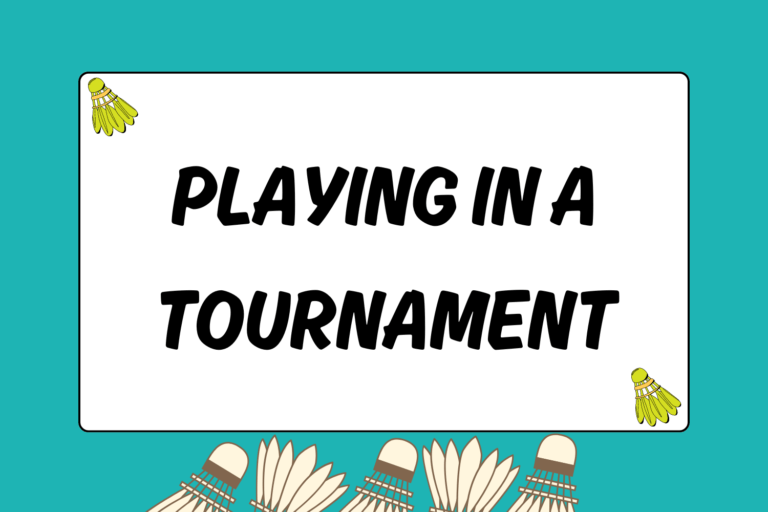While every badminton player’s style is unique, there are certain aspects that are just simply mistakes.
This guide will focus on the five most common mistakes that beginners (and even some advanced players) make. Be honest with yourself so you can overcome your bad habits and take your game to the next level.
Forehand Panhandle Grip
Probably the most common and glaring issue for badminton players is using an incorrect forehand grip. Instead, some players use a panhandle grip, which is actually intended for drive shots only.
The problem with using a panhandle grip for a forehand swing is the amount of power lost in the stroke. By holding the racket panhandle-style, the swing becomes much more vertical instead of coming across your body. A vertical swing does not use your strong pectoral muscles and instead relies mostly on your triceps.
To correct this mistake, you need to:
Examine your grip
Take a moment and look over your grip. Remember, your forehand grip should resemble the act of shaking hands. Holding the racket straight out in front of you should cause your arm and racket to form a straight line.
Relearn your swing
Trying to change the fundamentals of a basic stroke is not easy, especially if you’ve been doing it one way for a long time. The key is having proper body rotation and making sure your racket comes across your body.
This means if your right hand is your dominant hand, you should prepare for an overhead clear with your right foot back and your left foot forward. As you finish your swing, your upper body should be facing the net with your racket down near your left leg. After the swing, make sure your right foot comes forward so you can head back to your base point.
Illegal Serves
In this case, illegal serves strictly refer to contacting the shuttle above the legal height, which is the lowest rib of your rib cage. This usually only affects backhand serves, but forehand serves are certainly not out of the question.
In the recreational community, illegal serves are not a big deal to most players. In competitive tournaments, however, players will typically speak up about questionable serves. It takes a fair amount of time to tweak your serve, so it’s best to address this issue before an opponent brings it up.
To change your serve, start by:
Finding a legal point of contact
To do this, you’ll need a partner to watch you serve. Again, the shuttle’s contact point needs to be below your lowest rib.
Like most shots in badminton, the serve is highly dependent on your feel for it. As such, lowering your service by an inch or two will take some time to adjust.
Repetition
Altering your serve will never feel normal at first, but through practice and repetition, you’ll become more comfortable. It’s possible that your serves may be slightly worse than before, but that’s probably because you have been serving illegally.
Smashing Too Hard
One of the bad habits many players fall into is swinging too hard on smashes. There are two problems with smashing too hard: expending too much energy and losing control over your placement. Smashing your hardest to score a point is fine, but you’ll likely need to smash many more times as the match progresses.
So how do you know when you’re smashing too hard? The simple answer is: If it hurts your arm or wrist, you’re probably smashing too hard. The other way of knowing requires a bit of observation on your part. If you cannot adequately place the shuttle or if your smashes become weaker as the match goes on, then you should dial back your smashes just a tad.
To find the right balance of placement and power:
Monitor your smashes
If you can produce a strong smash while still being accurate, then you’re in good shape. When you notice your energy or consistency starting to drop, you’ll want to adjust your smash by focusing more on placement than power.
Monitor your opponents
If you find your smashes ineffective, the problem may not lie with you. If your opponents are exceptionally good at smash defense, then you should be stingier with your smashes.
Rather than smashing to gain an offensive advantage, smash after you’ve used other means to gain that advantage.
Clearing Too Often
There are many variables to consider when determining if a clear is a good shot at any given time. For moments when you need extra time to reset yourself, clearing is your best option. However, if your opponent hits a weak clear, then clearing it back only gives up the advantage your opponent just handed you. Essentially, any time you have the opportunity to attack, you should not clear. Although a driving clear can be an offensive shot, it is probably the weakest of your options.
There are two situations when players normally make the mistake of clearing:
Clearing serve returns
The instant a serve is taken, the battle to gain an offensive advantage begins. As the recipient of a serve, the serve return is the first opportunity you get to tilt the rally in your favor. Smashes, drops, and drives are all great serve returns.
For doubles players, this is especially true because there is less space for you to work with. Rush the short serves and attack the long serves. Most importantly, don’t give your opponent a chance by clearing.
Clearing offensive shots
Clearing a smash or drop is usually not an ideal return because clearing will allow your opponent to maintain the advantage he already has.
Unless your clear pushes your opponent all the way to the back of the court, he will likely have an even better opportunity to attack.
Getting Frustrated
Badminton players are often hard on themselves for mistakes made during a match. Everyone misses easy shots from time to time, even during pivotal rallies. The worst thing you can do is let your frustration and emotions affect your play.
Every rally is more important than the previous one, so instead of dwelling on your mistakes, take note of them and make any necessary adjustments. There is simply no room for anger and disappointment in competitive play. Here are some ways to deal with your frustration on the court:
Take it in stride
One mistake doesn’t immediately offset all the other great shots you’ve made. Focusing too much on a missed opportunity will only lead to more mistakes that could have otherwise been avoided.
Use mistakes to your advantage
You will only be able to learn and adjust from your mistakes if you maintain a clear head. Noticing trends in your mistakes is the easiest way to stop the bleeding and perhaps even turn the match in your favor.
Nobody’s Perfect
Impeccable technique does not translate to impeccable play. Everyone has their own style, and unorthodox technique or unconventional form is not necessarily a cause for change.
The key is to work on aspects of your game that you feel are lacking. Go back to the fundamentals, and ultimately you’ll find what works best for you.





